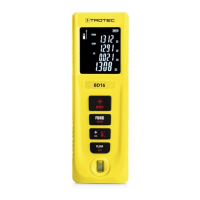3 EN
Operating manual – laser distance measuring device BD16
Residual risks
Warning of laser radiation
Laser class2, P max.: > 1mW, λ: 650nm,
EN 60825-1:2014
Do not look directly into the laser beam or the opening
from which it emerges.
Never point the laser beam at people, animals or
reflective surfaces. Even brief eye contact can lead to
eye damage.
Examining the laser output aperture by use of optical
instruments (e.g. magnifying glass, magnifiers and the
like) entails the risk of eye damage.
When working with a laser of class2, observe the
national regulations on wearing eye protection.
Warning
Risk of suffocation!
Do not leave the packaging lying around. Children may
use it as a dangerous toy.
Warning
The device is not a toy and does not belong in the
hands of children.
Warning
Dangers can occur at the device when it is used by
untrained people in an unprofessional or improper way!
Observe the personnel qualifications!
Caution
Keep a sufficient distance from heat sources.
Notice
To prevent damages to the device, do not expose it to
extreme temperatures, extreme humidity or moisture.
Notice
Do not use abrasive cleaners or solvents to clean the
device.
Information about the device
Device description
The laser distance measuring device is used to determine
distances, areas and volumes in interior spaces. Indirect
measurements are carried out employing the Pythagoras
function.
The multi-line, illuminated displayindicates the determined
values.
Owing to the dust- and splash-proof housing (IP54), the device
is also suited for use on construction sites.
Measuring distance
The range of the device can be gathered from the Technical
data chapter. Under certain conditions – e.g. at night, in twilight
or when the target is hidden in the shade – greater distances
are possible even without target plate. During the day use a
target plate to increase the distance for poorly reflecting targets.
Target surfaces
There might be measurement errors when the laser encounters
colourless liquids (e.g. water), dust-free glass, styrofoam or
other semi-permeable materials. The measurement result may
also be falsified if the laser encounters a high-gloss surface and
is deflected by it. Non-glossy, non-reflective or dark surfaces
can extend the measurement duration.

